Description:
Full calf. Probable first issue of the Stowe Edition with Chaucer's arms dated 1560 and before woodcut additions. Relative to the precedence of issues of the 1561 Stowe edition David R. Carlson ("The Woodcut Illustrations in Early Printed Editions of Chaucer's Canterbury Tales," in Chaucer Illustrated: Five Hundred Years of The Canterbury Tales in Pictures [British Library, 2003]) states "the most plausible explanation seems to be that the printer and publisher of the [Stowe] edition, came into possession of the woodcuts belatedly after most of the press work for the edition had been done. After obtaining the blocks, they ran up a new issue of the beginning of the book, incorporating a "General Prologue" illustrated with woodcut. In all documented cases, the unillustrated [i.e. first]"General Prologue" occurs with a title page showing the Chaucer arms, dated 1560 at the top of the shield. A different title-page, dated 1561, is found in copies incorporating the [woodcut] illustrated…
Read More Spiegel der waren Rhetoric by Friedrich Riederer - 11 December 1493
by Friedrich Riederer
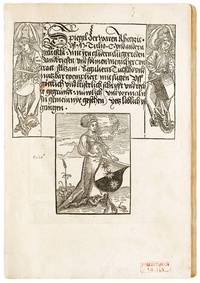
Spiegel der waren Rhetoric
by Friedrich Riederer
- Used
- first
Freiburg im Breisgau: Friedrich Riederer, 11 December 1493. – First edition.
The first complete rhetoric in German.
Friedrich Ried(e)rer's (c. 1450-c. 1510) work has to be esteemed as a landmark in the domain of rhetoric. Comprising ars rhetorica, ars dictandi and ars notaria, Riederer's book was intended for the most important fields of communication in his time, where rhetorical knowledge was used: chancery writers, notary's and other offices, scholarly research and teaching, preaching, municipal judicature and administration. The text is extensively treating the classical rhetorical theory including translations of parts of Cicero's De inventione and other texts. Moreover, it contains also detailed manuals on epistles and on legal contracts, providing a number of models.
Riederer was an interesting and erudite character, both active as a humanist writer and a printer. He ran the second printing press at Freiburg im Breisgau and this is his first dated book. It was very successful and was reprinted in Strasbourg in 1505, 1509, 1517, and again in Augsburg, 1535. Riederer apparently specialised on rhetorical and poetical works, including a Latin tract by his contemporary Jakob Locher Epitoma Rhetorices (1496).
The illustrations in this edition are regarded as the first woodcuts printed in Freiburg. The xylographic title shows artistic resemblances to Schongauer's and Dürer's works. The calligraphic script of the heading is flanked by two angels holding the coats of arms of the rulers of Friedingen and those of Steckborn (both near Lake Constance). Beneath is another fine woodcut with an elegant lady holding the armorial device of the author/printer, which reappears on the last leaf. This illustration has often been related to a drawing by Dürer, today in Bayonne (Musée Bonnat), representing a young woman in a fashionable dress. The woodcut was even thought to have been designed by the young Albrecht Dürer, withdrawn, however, by more recent research.
The full-page woodcut on the verso of fol. a1 shows an allegorical scene: The young lady Rhetorica offers brilliant eloquence in form of a radiant mirror that looks like a sun or a star to a king at his court. This illustration is signed with the initials MM, once suggested as a work by the artist Matthes Maler from Erfurt (Nagler, no. 1999). This theory was dismissed as Matthes is not testified before 1511 and neither his style nor his monogram resembles the present woodcut.
The illustration on leaf k5 showing Daedalus and Icarus is regarded the first printed representation of a flying human. It is not clear, however, whether this motive was exclusively designed for Riederer's Spiegel, or if it stemmed from another edition, as for example Ovid's Metamorphoses. Nevertheless the author incorporates the image in his argumentation when he points out that the writer should use his words considerately, like Daedalus who avoided flying too high or too low. Those who are boisterous and overexcited will soon lose their reader's respect and attention.
Provenance: 1. South Tyrol, the noble family Niederthor, their coat of arms within a wreath on leaf a2. The family died out in 1559. Today, this coat of arms is used by the village Terlan (near Bozen). – 2. Library stamp on title, partly erased, place illegible. – 3. Schweinfurt, Otto Schäfer collection (OS 1418), acquired in 1988.
Description of this copy: Folio, 305 x 216 mm. 188 leaves: ff. [1], II-CLXXX, [8]. – Types 1:94G, 2:140G, 3:83G, 44 lines and headline. With 4 woodcut illustrations including woodcut title.
Condition: Slight damp-staining at upper margin, a few wormholes at the beginning. Few restored tears in margins, only one (q2) affecting text. Some slight browning of leaves apparently due to the original manufacturing process of the paper. – Lower compartment of spine discoloured, joints partly cracked.
Binding: Contemporary dark brown blind-stamped calf on bevelled wooden boards, three raised bands, two clasps. The covers are richly tooled with border rolls and stamps to a panel design, including title on upper cover: "rhetorica".
Literature: Davies, Fairfax Murray, German, 1913, no. 364. – Friedrich Riederer, Spiegel der wahren Rhetorik (1493), ed. by J. Knape and S. Luppold, Wiesbaden 2008. (Kommentar zu Friedrich Riederers Spiegel der wahren Rhetorik, ed. J. Knape and S. Luppold, Wiesbaden 2010.) – Goff R-197. – GW M38173. – Hain-Copinger, 1895, no. 13914. – Hieronymus, F. Oberrheinische Buchillustration I, Basel 1972, no. 57. – ISTC ir00197000. – London, BMC III, p. 696. – Meder, J. Dürer-Katalog. Vienna 1932, p. 272, no. IV. – Munich, BSB-Ink R-183. – Nagler, Monogrammisten IV, 1871, no. 1999. – Schoch/Mende/Scherbaum, eds. Albrecht Dürer, Das druckgraphische Werk III. Munich 2004, no. A32. – Schreiber, no. 5096.
The first complete rhetoric in German.
Friedrich Ried(e)rer's (c. 1450-c. 1510) work has to be esteemed as a landmark in the domain of rhetoric. Comprising ars rhetorica, ars dictandi and ars notaria, Riederer's book was intended for the most important fields of communication in his time, where rhetorical knowledge was used: chancery writers, notary's and other offices, scholarly research and teaching, preaching, municipal judicature and administration. The text is extensively treating the classical rhetorical theory including translations of parts of Cicero's De inventione and other texts. Moreover, it contains also detailed manuals on epistles and on legal contracts, providing a number of models.
Riederer was an interesting and erudite character, both active as a humanist writer and a printer. He ran the second printing press at Freiburg im Breisgau and this is his first dated book. It was very successful and was reprinted in Strasbourg in 1505, 1509, 1517, and again in Augsburg, 1535. Riederer apparently specialised on rhetorical and poetical works, including a Latin tract by his contemporary Jakob Locher Epitoma Rhetorices (1496).
The illustrations in this edition are regarded as the first woodcuts printed in Freiburg. The xylographic title shows artistic resemblances to Schongauer's and Dürer's works. The calligraphic script of the heading is flanked by two angels holding the coats of arms of the rulers of Friedingen and those of Steckborn (both near Lake Constance). Beneath is another fine woodcut with an elegant lady holding the armorial device of the author/printer, which reappears on the last leaf. This illustration has often been related to a drawing by Dürer, today in Bayonne (Musée Bonnat), representing a young woman in a fashionable dress. The woodcut was even thought to have been designed by the young Albrecht Dürer, withdrawn, however, by more recent research.
The full-page woodcut on the verso of fol. a1 shows an allegorical scene: The young lady Rhetorica offers brilliant eloquence in form of a radiant mirror that looks like a sun or a star to a king at his court. This illustration is signed with the initials MM, once suggested as a work by the artist Matthes Maler from Erfurt (Nagler, no. 1999). This theory was dismissed as Matthes is not testified before 1511 and neither his style nor his monogram resembles the present woodcut.
The illustration on leaf k5 showing Daedalus and Icarus is regarded the first printed representation of a flying human. It is not clear, however, whether this motive was exclusively designed for Riederer's Spiegel, or if it stemmed from another edition, as for example Ovid's Metamorphoses. Nevertheless the author incorporates the image in his argumentation when he points out that the writer should use his words considerately, like Daedalus who avoided flying too high or too low. Those who are boisterous and overexcited will soon lose their reader's respect and attention.
Provenance: 1. South Tyrol, the noble family Niederthor, their coat of arms within a wreath on leaf a2. The family died out in 1559. Today, this coat of arms is used by the village Terlan (near Bozen). – 2. Library stamp on title, partly erased, place illegible. – 3. Schweinfurt, Otto Schäfer collection (OS 1418), acquired in 1988.
Description of this copy: Folio, 305 x 216 mm. 188 leaves: ff. [1], II-CLXXX, [8]. – Types 1:94G, 2:140G, 3:83G, 44 lines and headline. With 4 woodcut illustrations including woodcut title.
Condition: Slight damp-staining at upper margin, a few wormholes at the beginning. Few restored tears in margins, only one (q2) affecting text. Some slight browning of leaves apparently due to the original manufacturing process of the paper. – Lower compartment of spine discoloured, joints partly cracked.
Binding: Contemporary dark brown blind-stamped calf on bevelled wooden boards, three raised bands, two clasps. The covers are richly tooled with border rolls and stamps to a panel design, including title on upper cover: "rhetorica".
Literature: Davies, Fairfax Murray, German, 1913, no. 364. – Friedrich Riederer, Spiegel der wahren Rhetorik (1493), ed. by J. Knape and S. Luppold, Wiesbaden 2008. (Kommentar zu Friedrich Riederers Spiegel der wahren Rhetorik, ed. J. Knape and S. Luppold, Wiesbaden 2010.) – Goff R-197. – GW M38173. – Hain-Copinger, 1895, no. 13914. – Hieronymus, F. Oberrheinische Buchillustration I, Basel 1972, no. 57. – ISTC ir00197000. – London, BMC III, p. 696. – Meder, J. Dürer-Katalog. Vienna 1932, p. 272, no. IV. – Munich, BSB-Ink R-183. – Nagler, Monogrammisten IV, 1871, no. 1999. – Schoch/Mende/Scherbaum, eds. Albrecht Dürer, Das druckgraphische Werk III. Munich 2004, no. A32. – Schreiber, no. 5096.
-
Bookseller
Independent bookstores
(CH)
- Format/Binding Contemporary blind-tooled calf on wooden boards, two clasps
- Book Condition Used
- Quantity Available 1
- Edition First edition
- Publisher Friedrich Riederer
- Place of Publication Freiburg im Breisgau
- Date Published 11 December 1493
- Keywords rhetoric, incunable, incunabula, woodcut illustration
- Size 305 x 216 mm

More Photos
Works. The Woorkes of Geffrey Chaucer, Newly Printed, with Divers Addicions, whiche were Never in Printe Before: With the siege and destruccion of the worthy citee of Thebes, compiled by Jhon Lidgate, Monke of Berie. As in the table more plainly dooeth appere. First issue of the Stowe Edition.
by Goeffrey Chaucer, edited and augmented by John Stowe
- Used
- very good
- Hardcover
- first
- Condition
- Used - Very Good
- Edition
- Fifth edition.
- Binding
- Hardcover
- Quantity Available
- 1
- Seller
-
Fort Lauderdale, Florida, United States
- Item Price
-
£24,387.00
Show Details
Item Price
£24,387.00

More Photos
DIZIONARIO ITALIANO E ARABO CHI CONTIENE IN SUCCINTO TUTTI I VOCABOLI CHE SONO PIU IN USO E PIU NECESSARI PER IMPARAR A PARLARE LE DUE LINGUE CORRETTAMENTE EGLI E DIVISO IN DUE PARTI (THE FIRST BOOK TO BE PRINTED IN BULAK)
by RAPHAEL ANTOINE ZAKHOUR (DON RAPHAEL)
- Used
- very good
- Hardcover
- first
- Condition
- Used - Very Good
- Edition
- 1st Edition
- Binding
- Hardcover
- ISBN 13
- 9781000012002
- ISBN 10
- 100001200X
- Quantity Available
- 1
- Seller
-
Riyadh, Saudi Arabia
- Item Price
-
£28,451.50
Show Details
Description:
Cairo: Bolacco (Bulak), 1822 Book. Very Good. Hardcover. 1st Edition. 4to - over 9¾ - 12" tall. EXTREEMLY RARE, ARABIC ITALIAN DICTIONARY, VOCABULARY AND TERMS, PAGINATED IN ARABIC AND LATIN, TITLE PAGE IN ARABIC, CONTAINS PRINTING DATE 1238 AND PLACE (TAMMA AL TAB'U FI BULAK BI MATBA'AAT SAHIB AL SA'AADAH), AND PREFACE BY THE AUTHOR IN ARABIC, SUBTITLE, 266 PP IN TOW COLUMNS, ARABIC AND ITALIAN, 4 PP ERRATA IN ITALIAN, 2 PP ERRATA IN ARABIC, AND ONE TITLE PAGE IN ITALIAN CONTAINS PRINTING DETAILS: BOLACCO DALLA STAMPERIA REALE 1822. 4TO. THE FIRST AND ONLY BOOK TO BE PRINTED IN BULAQ AND IN A NATIONAL PRINTING OFFICE IN EGYPT AFTER THE FRANCH EXPEDITION. THE BOOK CONSISTS OF TOW PARTS: (Part I): del dizionario disposto come il solito nell'ordine alfabetico. (Part II): Che contiene una breve raccolta di nomi e di verbi li piu necessari, e piu utili allo studio delle due lingue. THE AUTHOR WAS AN EGYPTIAN BORN FROM ALEPPO AND A CATHOLIC MONK. HE ACCOMANIED THE FRENCH EXPEDITION DURING IT'S DEPARTURE…
Read More Item Price
£28,451.50

Felix Frankfurter Reminisces (*Signed by Graham Greene* with a gift inscription to his former dean and English constitutional law professor Sir David Keir): An Intimate Portrait as Recorded in Talks with Dr. Harlan B. Phillips
by Phillips, Dr. Harlan B.
- Used
- near fine
- Hardcover
- Signed
- first
- Condition
- Used - Near Fine
- Jacket Condition
- Near Fine
- Edition
- First Edition
- Binding
- Hardcover
- Quantity Available
- 1
- Seller
-
Maysville, Georgia, United States
- Item Price
-
£24,387.00
Show Details
Description:
Hardcover. Non-Fiction. Memoirs. 310 pp. Secker & Warburg, London (1960). First Edition. First Printing (FPu). Clean, tight copy with no bumped corners and no markings inside or out. Near Fine/ Near Fine. The unique feature of the book, however, is the gift inscription on the front pastedown, all but hidden by the DJ flap. The book's gift inscription is from Graham Greene to his former constitutional law professor (and later dean) Sir David Keir at his alma mater Balliol College, Oxford University. The unique feature of the inscription is that it is written and signed in the looping cursive script of Greene's natural handwriting and legal signature; versus the printed hybrid script and autograph that he had adopted for public consumption at his booksignings. (Greene's upper-case G' s in his public and semi-private booksignings and inscriptions had evolved to more closely resemble lightning bolts or radically elongated, linear letter S's.) In reality, author Graham Greene was a champion of literate…
Read More Item Price
£24,387.00

Oud en Nieuw Oost-Indiën, vervattende een naaukeurige en uitvoerige verhandelinge van Nederlands Mogentheyd in die gewesten, benevens eene wydlustige beschryving der Moluccos, Amboina, Banda, Timor, en Solor, Java .. Suratte .. Choromandel, Pegu, Arracan, Bengale, Mocha, Persien, Malacca, Sumatra, Ceylon, Malabar, Celebes of Macassar, China, Japan, Tayouan of Formosa, Tonkin, Cambodia, Siam, Borneo, Bali, Kaap de Goede Hoop en van Mauritius.
by VALENTIJN, François.
- Used
- Hardcover
- first
- Condition
- Used
- Binding
- Hardcover
- Quantity Available
- 1
- Seller
-
Vianen, Netherlands
- Item Price
-
£37,575.56
Show Details
Description:
Dordrecht, Amsterdam, Joannes van Braam, Gerard onder de Linden, 1724-1726.5 parts in 8 volumes. Folio. Contemporary half calf, spines gilt and with black title-labels (later boards). With engraved allegorical frontispiece, printed title-page in red and black, folding portrait of Valentijn, 19 portraits of the Governors-General, and 326 illustrations, maps, plans, bird's-eye views and plates (most of them double-page or folding; including fragments of Javanese manuscripts).First edition. -The most important early work documenting the history of the Dutch East India Company (VOC) in the East Indies and the Far East, which never can be superseded as many of the documents of which the author made use, do not longer exist. François Valentijn (1666-1727) was a minister of the Dutch Reformed Church who lived for many years on Amboyna and Java. During this period he collected an enormous mass of information, especially in the fields of history, geography and ethnology, concerning all parts of the world…
Read More Item Price
£37,575.56
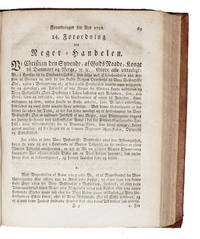
More Photos
Forordning om Neger=Handelen (i.e. Decree about the Negro-Trade). [In. Kong Christian den Syvendes allernaadigste Forordninger og aabne Breve for Aar 1792]. - [THE FIRST DECREE IN THE WORLD TO FORBID SLAVE-TRADE]
by [CHRISTIAN VII - SLAVE-TRADE].
- Used
- Hardcover
- first
- Condition
- Used
- Binding
- Hardcover
- Quantity Available
- 1
- Seller
-
Copenhagen, Denmark
- Item Price
-
£28,625.00
Show Details
Description:
1792. Kiøbenhavn, Høppfner, (16. Martius, 1792). 4to. The entire volume of "Forordninger...", 1792 bound with the entire volumes of 1790 and 1791 as well in a very nice strictly contemporary brown full calf binding with four raised bands, gilt title-label and lovely gilt ornamentatiions to spine as well as the gilt, crowned monogram of King Chritian the VII to top of spine. Light wear and a closed tear to top capital. Otherwise in splendid condition, in- as well as ex-ternally. Stamp from the Danish Royal Military Library to front free end-paper. Pp. 69-71. [Entire volume: 146, 12 pp., 1 f. blank + 288, (8) pp., two folded tables + 323, (13) pp. woodcut vignettes of the Danish Elephant-order to title-pages]. Extremely rare first printing of the very first law anywhere in the world to abandon slave trade. From the library of King Christian VII, who passed the law, with his crowned gilt monogram to spine. With the completely groundbreaking "Forordning on Neger=Handelen" ("Decree about the…
Read More Item Price
£28,625.00

More Photos
Works. The Woorkes of Geffrey Chaucer, Newly Printed, with Divers Addicions, whiche were Never in Printe Before: With the siege and destruccion of the worthy citee of Thebes, compiled by Jhon Lidgate, Monke of Berie. As in the table more plainly dooeth appere. First issue of the Stowe Edition.
by Goeffrey Chaucer, edited and augmented by John Stowe
- Used
- very good
- Hardcover
- first
- Condition
- Used - Very Good
- Edition
- Fifth edition.
- Binding
- Hardcover
- Quantity Available
- 1
- Seller
-
Fort Lauderdale, Florida, United States
- Item Price
-
£24,387.00
Show Details
Description:
Full calf. Probable first issue of the Stowe Edition with Chaucer's arms dated 1560 and before woodcut additions. Relative to the precedence of issues of the 1561 Stowe edition David R. Carlson ("The Woodcut Illustrations in Early Printed Editions of Chaucer's Canterbury Tales," in Chaucer Illustrated: Five Hundred Years of The Canterbury Tales in Pictures [British Library, 2003]) states "the most plausible explanation seems to be that the printer and publisher of the [Stowe] edition, came into possession of the woodcuts belatedly after most of the press work for the edition had been done. After obtaining the blocks, they ran up a new issue of the beginning of the book, incorporating a "General Prologue" illustrated with woodcut. In all documented cases, the unillustrated [i.e. first]"General Prologue" occurs with a title page showing the Chaucer arms, dated 1560 at the top of the shield. A different title-page, dated 1561, is found in copies incorporating the [woodcut] illustrated…
Read More Item Price
£24,387.00

More Photos
DIZIONARIO ITALIANO E ARABO CHI CONTIENE IN SUCCINTO TUTTI I VOCABOLI CHE SONO PIU IN USO E PIU NECESSARI PER IMPARAR A PARLARE LE DUE LINGUE CORRETTAMENTE EGLI E DIVISO IN DUE PARTI (THE FIRST BOOK TO BE PRINTED IN BULAK)
by RAPHAEL ANTOINE ZAKHOUR (DON RAPHAEL)
- Used
- very good
- Hardcover
- first
- Condition
- Used - Very Good
- Edition
- 1st Edition
- Binding
- Hardcover
- ISBN 13
- 9781000012002
- ISBN 10
- 100001200X
- Quantity Available
- 1
- Seller
-
Riyadh, Saudi Arabia
- Item Price
-
£28,451.50
Show Details
Description:
Cairo: Bolacco (Bulak), 1822 Book. Very Good. Hardcover. 1st Edition. 4to - over 9¾ - 12" tall. EXTREEMLY RARE, ARABIC ITALIAN DICTIONARY, VOCABULARY AND TERMS, PAGINATED IN ARABIC AND LATIN, TITLE PAGE IN ARABIC, CONTAINS PRINTING DATE 1238 AND PLACE (TAMMA AL TAB'U FI BULAK BI MATBA'AAT SAHIB AL SA'AADAH), AND PREFACE BY THE AUTHOR IN ARABIC, SUBTITLE, 266 PP IN TOW COLUMNS, ARABIC AND ITALIAN, 4 PP ERRATA IN ITALIAN, 2 PP ERRATA IN ARABIC, AND ONE TITLE PAGE IN ITALIAN CONTAINS PRINTING DETAILS: BOLACCO DALLA STAMPERIA REALE 1822. 4TO. THE FIRST AND ONLY BOOK TO BE PRINTED IN BULAQ AND IN A NATIONAL PRINTING OFFICE IN EGYPT AFTER THE FRANCH EXPEDITION. THE BOOK CONSISTS OF TOW PARTS: (Part I): del dizionario disposto come il solito nell'ordine alfabetico. (Part II): Che contiene una breve raccolta di nomi e di verbi li piu necessari, e piu utili allo studio delle due lingue. THE AUTHOR WAS AN EGYPTIAN BORN FROM ALEPPO AND A CATHOLIC MONK. HE ACCOMANIED THE FRENCH EXPEDITION DURING IT'S DEPARTURE…
Read More Item Price
£28,451.50

Felix Frankfurter Reminisces (*Signed by Graham Greene* with a gift inscription to his former dean and English constitutional law professor Sir David Keir): An Intimate Portrait as Recorded in Talks with Dr. Harlan B. Phillips
by Phillips, Dr. Harlan B.
- Used
- near fine
- Hardcover
- Signed
- first
- Condition
- Used - Near Fine
- Jacket Condition
- Near Fine
- Edition
- First Edition
- Binding
- Hardcover
- Quantity Available
- 1
- Seller
-
Maysville, Georgia, United States
- Item Price
-
£24,387.00
Show Details
Description:
Hardcover. Non-Fiction. Memoirs. 310 pp. Secker & Warburg, London (1960). First Edition. First Printing (FPu). Clean, tight copy with no bumped corners and no markings inside or out. Near Fine/ Near Fine. The unique feature of the book, however, is the gift inscription on the front pastedown, all but hidden by the DJ flap. The book's gift inscription is from Graham Greene to his former constitutional law professor (and later dean) Sir David Keir at his alma mater Balliol College, Oxford University. The unique feature of the inscription is that it is written and signed in the looping cursive script of Greene's natural handwriting and legal signature; versus the printed hybrid script and autograph that he had adopted for public consumption at his booksignings. (Greene's upper-case G' s in his public and semi-private booksignings and inscriptions had evolved to more closely resemble lightning bolts or radically elongated, linear letter S's.) In reality, author Graham Greene was a champion of literate…
Read More Item Price
£24,387.00
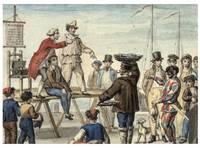
More Photos
Forty-six fine watercolours elegantly bound in a nineteenth-century album
by NOVELLI, Francesco
- Used
- first
- Condition
- Used
- Binding
- Unknown
- Quantity Available
- 1
- Seller
-
Sydney, New South Wales, Australia
- Item Price
-
£30,162.82
Show Details
Description:
Probaly Venice, 1825. An exquisite suite of watercolours, including a beautiful series of scenes documenting a Venetian commedia dell'arte troupe, by the Italian artist Francesco Novelli. Francesco Novelli (1767-1836), one of the preeminent artists of his generation, lived in Venice where he was best known for his outstanding book illustration. He enjoyed a long and successful career that culminated in the landmark editions of Don Quixote (1819) and Gil Blas (1820). Novelli is also known for illustrating works such as the Fasti Veneziani (1794), hinting at his abiding interest in the theatre and the performing arts. In this unmatched collection of Novelli's watercolours, the greatest number are piquant images of a troupe of the commedia dell'arte, with especially fine depictions of Pierrot himself, as well as other key figures such as Columbine and Harlequin. There is a remarkable series of scenes from a play, as well as studies of individual performers, many so precisely rendered that it is almost…
Read More Item Price
£30,162.82

Oud en Nieuw Oost-Indiën, vervattende een naaukeurige en uitvoerige verhandelinge van Nederlands Mogentheyd in die gewesten, benevens eene wydlustige beschryving der Moluccos, Amboina, Banda, Timor, en Solor, Java .. Suratte .. Choromandel, Pegu, Arracan, Bengale, Mocha, Persien, Malacca, Sumatra, Ceylon, Malabar, Celebes of Macassar, China, Japan, Tayouan of Formosa, Tonkin, Cambodia, Siam, Borneo, Bali, Kaap de Goede Hoop en van Mauritius.
by VALENTIJN, François.
- Used
- Hardcover
- first
- Condition
- Used
- Binding
- Hardcover
- Quantity Available
- 1
- Seller
-
Vianen, Netherlands
- Item Price
-
£37,575.56
Show Details
Description:
Dordrecht, Amsterdam, Joannes van Braam, Gerard onder de Linden, 1724-1726.5 parts in 8 volumes. Folio. Contemporary half calf, spines gilt and with black title-labels (later boards). With engraved allegorical frontispiece, printed title-page in red and black, folding portrait of Valentijn, 19 portraits of the Governors-General, and 326 illustrations, maps, plans, bird's-eye views and plates (most of them double-page or folding; including fragments of Javanese manuscripts).First edition. -The most important early work documenting the history of the Dutch East India Company (VOC) in the East Indies and the Far East, which never can be superseded as many of the documents of which the author made use, do not longer exist. François Valentijn (1666-1727) was a minister of the Dutch Reformed Church who lived for many years on Amboyna and Java. During this period he collected an enormous mass of information, especially in the fields of history, geography and ethnology, concerning all parts of the world…
Read More Item Price
£37,575.56

Secret Splendor (Silhouette Classics, No 11)
by Claire, Erin St (Sandra Brown)
- Used
- very good
- Paperback
- Condition
- Used - Very Good
- Binding
- Paperback
- ISBN 13
- 9780373482474
- ISBN 10
- 0373482477
- Quantity Available
- 1
- Seller
-
Olive Hill, Kentucky, United States
- Item Price
-
£2.44
Show Details
Description:
Silhouette, 1992. Paperback. Very Good. Sandra Brown writing as Erin St. Claire, 253 pgs
Item Price
£2.44

More Photos
Bloody Sunrise
by Spillane, Mickey
- Used
- very good
- Hardcover
- first
- Condition
- Used - Very Good
- Jacket Condition
- Very Good
- Edition
- First Edition
- Binding
- Hardcover
- Quantity Available
- 1
- Seller
-
Tempe, Arizona, United States
- Item Price
-
£8.92£3.57Save £6.58!
Show Details
Description:
1965 - First Edition stated - A Tiger Mann Mystery - "...for Tiger is told on his wedding day that he is needed for Operation Plato." - book: very good - tight, sound, and square - no previous owner markings - dj: vibrant colors with some rubbing to the black base and abstract sun - interesting black and white photo of Spillane on the back cover - a few chips repaired with archival tape - dj in protective mylar sleeve
Item Price
£8.92£3.57
Save £6.58
!
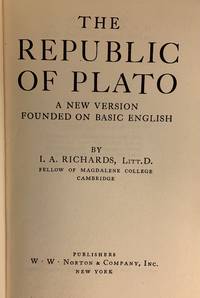
More Photos
The Republic Of Plato: A New Version Founded On Basic English
by Richards, I.A
- Used
- Hardcover
- Condition
- Used
- Binding
- Hardcover
- Quantity Available
- 1
- Seller
-
Tempe, Arizona, United States
- Item Price
-
£10.56£4.23Save £7.79!
Show Details
Description:
1942 - noted on the copyright page as "A WARTIME BOOK This complete edition is produced in full compliance with the government's regulations for conserving paper and other essential materials" book: very good -tight, sound, and square, no previous owner marks - moderate edgewear plus rubbing to the boards - some toning from age - no dj - includes a vintage (pre - "The Google") Buccaneer Books Laguna Beach, CA out-of-print book search card
Item Price
£10.56£4.23
Save £7.79
!

More Photos
Mars 1999 (INSCRIBED) (FIRST)
by O'Leary, Brian
- Used
- very good
- Hardcover
- Signed
- first
- Condition
- Used - Very Good
- Jacket Condition
- Very Good
- Edition
- First Edition
- Binding
- Hardcover
- Quantity Available
- 1
- Seller
-
Tempe, Arizona, United States
- Item Price
-
£13.00£5.20Save £9.59!
Show Details
Description:
1987 - 1st ed ("1" in number line) - INSCRIBED to include shark-faced rocket cartoon - "Exclusive Preview of the U.S. - Soviet Manned Mission - book: very good - pages show toning from age - dj: very good - some toning from age - dj in protective mylar sleeve
Item Price
£13.00£5.20
Save £9.59
!

More Photos
John Wayne America: Why I Love Her
by Liebert, Billy and Mitchum, John
- Used
- Hardcover
- first
- Condition
- Used - Very Good +
- Jacket Condition
- Very Good
- Edition
- First Edition
- Binding
- Hardcover
- Quantity Available
- 1
- Seller
-
Tempe, Arizona, United States
- Item Price
-
£13.00£5.20Save £9.59!
Show Details
Description:
1977 - collectable 1st edition ("1" present) Photographs and stories for each piece of music. Words and sheet music arranged for piano and guitar from John Wayne's best-selling record album... Sheet music for: Why I love Her The Hyphen My Roots Are Buried Here The People An American Boy Grows Up Face the Flag The Good Things The Pledge of Allegiance Why Are You Marching Son? Taps book: very good - tight, sound, and square - all pages are clean and unmarked - dj: very good - not price clipped - some tears/chipping at top of dj have been repaired with archival tape - some overall toning from age - dj wrapped in protective sleeve
Item Price
£13.00£5.20
Save £9.59
!

More Photos
Cognac a Liquid History (INSCRIBED) (FIRST)
by Calabrese, Salvatore
- Used
- Signed
- first
- Condition
- Used - Very Good-
- Jacket Condition
- Very Good
- Edition
- First Edition
- Quantity Available
- 1
- Seller
-
Tempe, Arizona, United States
- Item Price
-
£20.30£8.12Save £14.98!
Show Details
Description:
2001 - 1st edition - INSCRIBED by author on the title page "To Anthony Salute 18 03 05" - prior owner inscription "With love for Michelle 26 Dec 2014" - "Seen through the eyes of Salvatore Calabrese, a renowned and respected cognac expert, this book is a personal and insightful perspective on the spirit that earned its image of virility and strength from Napoleon Bonaparte." - book; very good - filled with images - tight, sound, and square - all pages are clean and unmarked, no folded page corners, dj: not price clipped [Price in UK 25.00] - small dime size chip on the back upper left corner repaired with archival tape - slight amount of scuffing - dj in protective mylar sleeve
Item Price
£20.30£8.12
Save £14.98
!
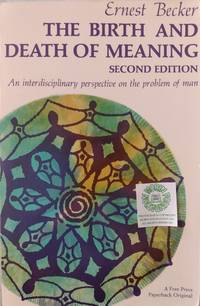
More Photos
The Birth and Death of Meaning: An Interdisciplinary Perspective on the Problem of Man
by Becker, Ernest
- Used
- good
- Paperback
- Condition
- Used - Good
- Jacket Condition
- No Jacket
- Edition
- 2nd
- Binding
- Paperback
- Quantity Available
- 1
- Seller
-
Newton, Massachusetts, United States
- Item Price
-
£8.13
Show Details
Description:
New York: The Free Press, 1971. Second Edition. Contents include: The Man-Apes; The Origins of the Mind; The Distinctive Human; The Inner World; Socialization: the Creation of the Inner World; The New Meaning of the Oedipus Complex; Self-Esteem; Culture and Personality; Social Encounters: The Staging of Self-Esteem; Culture: the Relativity of Hero-Systems; What is Normal?; What Would A Science of Man Then Be?; Religion: The Quest for the Ideal Heroism. 228 pages. Edgewear; light wear to covers; worn corners and light creases on spine. Deeply creased spine opens flat at pages 60/61. Thanks for shopping with us! 100% of your purchase benefits charity and supports literacy and lifelong learning.. 2nd. Soft Cover. Good/No Jacket. 8vo - over 7¾" - 9¾" tall.
Item Price
£8.13

More Photos
Unreal Tournament Bradygames Official Strategy Guide
by Marcus, Phillip
- New
- Paperback
- Condition
- New
- Jacket Condition
- No Jacket
- Binding
- Paperback
- ISBN 13
- 9780744009552
- ISBN 10
- 0744009553
- Quantity Available
- 1
- Seller
-
Newton, Massachusetts, United States
- Item Price
-
£8.13
Show Details
Description:
Bradbury & Evans, 2007. Covers PC-CD ROM/DVD ROM & Playstation 3 Computer Entertainment System 4to sized softcover; 271 heavy glossy pages with color illustrations throughout Brand new, but note some edgewear and blemish to top of back cover. Thanks for shopping with us. 100% of your purchase benefits charity and supports literacy and life-long learning.. Trade Paperback. New/No Jacket. 4to - over 9¾" - 12" tall.
Item Price
£8.13

More Photos
More Than Forever
by McLean, Jay
- Used
- good
- Paperback
- Condition
- Used - Good
- Jacket Condition
- No Jacket
- Binding
- Paperback
- ISBN 13
- 9781505999471
- ISBN 10
- 1505999472
- Quantity Available
- 1
- Seller
-
Newton, Massachusetts, United States
- Item Price
-
£8.13
Show Details
Description:
2014. Book Four in the More Than Series 8vo size trade paperback; 369 pages Please note: This book has a Mature Readers Advisory. From back: "Lucy - There is love so fierce it cannot be measured... Cameron - Forever. Everlasting. Eternal. THere is no measure of time... But our forever isn't always." Creased back cover and last few pages, worn corners. Thanks for shopping with us. 100% of your purchase benefits charity and supports literacy and life-long learning.. Trade Paperback. Good/No Jacket. 8vo - over 7¾" - 9¾" tall. Private Press.
Item Price
£8.13
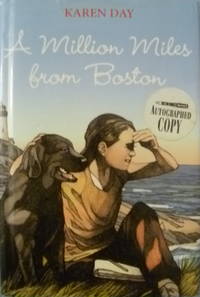
More Photos
A Million Miles from Boston
by Day, Karen
- Used
- good
- Hardcover
- Signed
- first
- Condition
- Used - Good
- Jacket Condition
- Good
- Edition
- First
- Binding
- Hardcover
- ISBN 13
- 9780385738996
- ISBN 10
- 0385738994
- Quantity Available
- 1
- Seller
-
Newton, Massachusetts, United States
- Item Price
-
£8.94
Show Details
Description:
2011. 8vo size hardcover with dust jacket; 215 pages. Signed by author on title page. Stated First Edition From jacket: "(Lucy) wants to get out of Boston and forget her worries about starting middle school and about her father's new girlfriend. Pierson Point is where she feels most like herself, and where memories of her mother, who died when Lucy was six, are strong and sacred. But this summer, nothing is the same. Ian, a boy from home in Boston, comes to Pierson Point...Lucy's father wants his girlfriend to become a bigger part of Lucy's life. Though Lucy struggles against change, she gradually realizes that sometimes, change is for the better. Average wear to jacket; bumped corners and head and heel of spine, owner's name on fep. Autographed Copy sticker on front of jacket; one previously folded page corner. Quotes are for illustrative purposes only and remain the property of their copyright holders. Thanks for shopping with us. 100% of your purchase benefits…
Read More Item Price
£8.94
